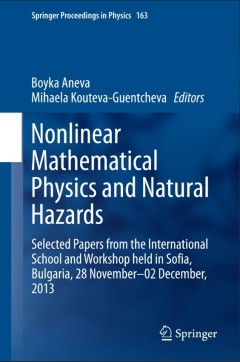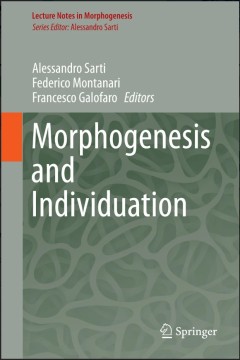Filter by

Thinking Ahead - Essays on Big Data, Digital Revolution, and Participatory Ma…
The rapidly progressing digital revolution is now touching the foundations of the governance of societal structures. Humans are on the verge of evolving from consumers to prosumers, and old, entrenched theories – in particular sociological and economic ones – are falling prey to these rapid developments. The original assumptions on which they are based are being questioned. Each year we pro…
- Edition
- -
- ISBN/ISSN
- 10.1007/978-3-319-15078-9
- Collation
- XIII, 194
- Series Title
- -
- Call Number
- -

Nonlinear Mathematical Physics and Natural Hazards
This book is devoted to current advances in the field of nonlinear mathematical physics and modeling of critical phenomena that can lead to catastrophic events. Pursuing a multidisciplinary approach, it gathers the work of scientists who are developing mathematical and computational methods for the study and analysis of nonlinear phenomena and who are working actively to apply these tools and c…
- Edition
- 1
- ISBN/ISSN
- 0930-8989
- Collation
- XXVI, 141
- Series Title
- Springer Proceedings in Physics
- Call Number
- -

Energy Flow Theory of Nonlinear Dynamical Systems with Applications
This monograph develops a generalised energy flow theory to investigate non-linear dynamical systems governed by ordinary differential equations in phase space and often met in various science and engineering fields. Important nonlinear phenomena such as, stabilities, periodical orbits, bifurcations and chaos are tack-led and the corresponding energy flow behaviors are revealed using the propos…
- Edition
- -
- ISBN/ISSN
- 978-3-319-17741-0
- Collation
- 65 b/w illustrations
- Series Title
- -
- Call Number
- -

Theory of Liquids and Other Disordered Media
This set of lectures provides an introduction to the structure, thermodynamics and dynamics of liquids, binary solutions and polymers at a level that will enable graduate students and non-specialist researchers to understand more specialized literature and to possibly start their own work in this field. Part I starts with the introduction of distribution functions, which describe the statist…
- Edition
- -
- ISBN/ISSN
- 978-3-319-06950-0
- Collation
- 19 b/w illustrations, 36 illustrations in colour
- Series Title
- -
- Call Number
- -

Morphogenesis and Individuation
This contributed volume aims to reconsider the concept of individuation, clarifying its articulation with respect to contemporary problems in perceptual, neural, developmental, semiotic and social morphogenesis. The authors approach the ontogenetical issue by taking into account the morphogenetic process, involving the concept of individuation proposed by Gilbert Simondon and Gilles Deleuze. Th…
- Edition
- 1
- ISBN/ISSN
- 2195-1934
- Collation
- -
- Series Title
- Lecture Notes in Morphogenesis
- Call Number
- -

Emergent Spatio-temporal Dimensions of the City Habitus and Urban Rhythms
This book focuses on the creation of space as an activity. The argument draws not only on aspects of movement in time, but also on a cultural and specifically social context influencing the creation of the spatial habitus. The book reconsiders existing theories of time and space in the field of urban planning and develops an updated account of spatial activity, experience and space-making. Rece…
- Edition
- 1
- ISBN/ISSN
- 978-3-319-09849-4
- Collation
- 41 b/w illustrations, 80 illustrations in colour
- Series Title
- -
- Call Number
- -

Emergent Nested Systems A Theory of Understanding and Influencing Complex Sy…
This book presents a theory as well as methods to understand and to purposively influence complex systems. It suggests a theory of complex systems as nested systems, i. e. systems that enclose other systems and that are simultaneously enclosed by even other systems. According to the theory presented, each enclosing system emerges through time from the generative activities of the systems they e…
- Edition
- 1
- ISBN/ISSN
- 978-3-319-27550-5
- Collation
- 8 b/w illustrations, 98 illustrations in colour
- Series Title
- -
- Call Number
- -
 Computer Science, Information & General Works
Computer Science, Information & General Works  Philosophy & Psychology
Philosophy & Psychology  Religion
Religion  Social Sciences
Social Sciences  Language
Language  Pure Science
Pure Science  Applied Sciences
Applied Sciences  Art & Recreation
Art & Recreation  Literature
Literature  History & Geography
History & Geography